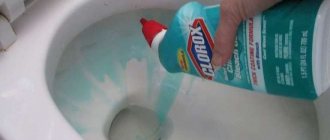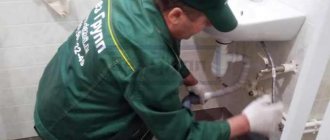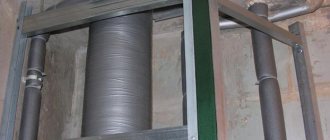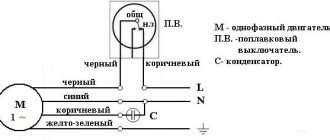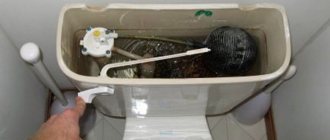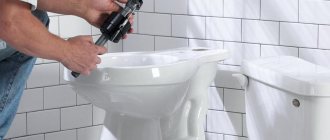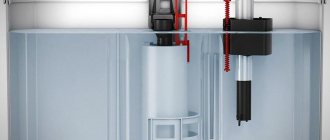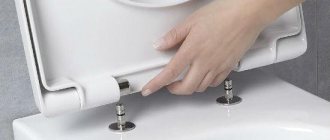Cleaning cesspools and toilets - how to understand that the pit needs to be cleaned
A cesspool is usually represented by a sealed tank. This means that all wastewater is mostly retained in the tank. To prevent the contents from overflowing beyond the walls, inspection wells or doors are provided. Pumping occurs through them. The acceptable filling rate is considered to be ⅔ of the total volume.
In addition to visual analysis of the situation, there are three signs indicating that the reservoir is full:
- the flow of water from plumbing equipment (sink, bathtub, toilet) slows down;
- gurgling sounds are heard in sewer pipes;
- a characteristic smell appears in the house and yard.
Partial liquid seeps through the bottom and walls and goes into the ground.
But the ducts become clogged with solid particles, so you need to periodically monitor the fullness of the pit and clean it in a timely manner. There may be an obstacle to the natural filtration of wastewater in the form of silt formations. The reason for their appearance is incomplete or rare removal of sediment from the cesspool.
Cleaning the toilet
To understand how to remove limescale on a toilet, it is important to know that all cleaning agents are divided into three types:
- alkaline;
- abrasive;
- acidic.
Alkaline products are safe, odorless, but have disinfectant properties. With their help, it is easy to remove limescale deposits in the toilet and organic pollution. Sold in liquid form, it fights well against surface stains.
Using abrasive agents, that is, cleaning powders, you can wash both the toilet itself and the flush cistern
It is important to remember that powder products do not wash off well and can leave roughness on surfaces. Dirt will more often accumulate in them, so after cleaning the plumbing fixtures should be rinsed thoroughly with water.
And finally, acidic agents. These are serious cleaners that can remove old limescale from your plumbing fixtures. Such products contain formic, phosphoric and hydrochloric acid. It’s not difficult to guess that when using such products, you must definitely use protective equipment: thick rubber gloves, a respirator and, preferably, goggles. The room should be well ventilated after treatment.
How to remove ingrained yellow plaque in the back of the toilet
Many housewives are tormented by the question of how to remove limescale deposits in the depths of plumbing? In fact, all the same products that are used to clean plaque under the rim or in the tank will help. But there is a nuance: to remove the yellowness in the depths, you need to drain all the water and pour the cleaning agent into it. This cleaning procedure is best done at night. In the evening, pour in the cleaning agent, and in the morning, rub well with a brush and rinse off the product.
DIY cleaning methods
When cleaning the cesspool yourself, you need to take care of a respirator with a filter element. It will prevent poisoning from toxic fumes and gases. The use of special preparations with a bacterial or chemical environment allows you to delay the cleaning process, get rid of the smell, and protect the environment in the septic tank. But drains still have to be removed periodically.
Mechanical, description
Initially, cleaning the cesspool was carried out with a bucket on a fairly long handle. Subsequently, the wastewater was more often used for home production of fertilizers through compost. So today you can save on technology, equipment or special medications. But there is a risk of gas poisoning, loss of consciousness from ammonia and hydrogen sulfide. If the container is large, you will have to purchase sealed workwear with shoes and seek help due to the labor-intensive nature of the event.
If the site allows, you can change the location of the waste collection point. But before burying the old hole, the contents still need to be removed. This approach is relevant in case of heavy siltation of the bottom and walls.
To speed up the process of cleaning the septic tank yourself, you can use pumping equipment. There are models with automatic shut-off to avoid idling. Another option is with a built-in chopper. This approach is effective and therefore popular despite the energy costs. The third option is to call a sewer truck.
Biological
This method involves the addition of bacteria and compliance with specific conditions. The effectiveness of the method lies in the conversion of wastewater into water and organic sludge. Results become noticeable within 1-2 weeks. The action must be accompanied by warm weather (over 7 degrees Celsius). To activate the process, sugar and yeast are added and a constant flow of water is ensured.
Bioactivator "Doctor Robik 109", for cesspools, 75 grams
Bioactivator "Doctor Robik 109", for cesspools, 75 grams
my-shop.ru
Buy
Bioactivator "Biosept", 300 g
Bioactivator "Biosept", 300 g
my-shop.ru
Buy
Means for cesspools and septic tanks Sanfor “Bioactivator”, 40 g
Means for cesspools and septic tanks Sanfor “Bioactivator”, 40 g
my-shop.ru
Buy
Activator "Biosept", 600 g
Activator "Biosept", 600 g
my-shop.ru
Buy
The advantages of biological products include:
- no odor;
- simplified cleaning;
- Possibility of using sludge for compost.
If the bottom is of a drainage type, then you will only need to remove organic residues. The liquid will freely go into the ground. This allows you to delay cleaning the pit.
Additional Information! In cold weather, microorganisms do not perform their task. The same thing happens due to household detergents, powders, hygiene products, and compositions containing chlorine. But there are bacteria that can cope with dissolved toilet paper.
The release form of the drugs is different. Some must first be prepared for use. More often this is dilution of granules or powder in clean water. Gels and liquids can be poured into the pit immediately.
Chemical
Chemicals can be used for a cesspool for general collection of wastewater from the toilet, bathroom, kitchen, and bathhouse. Based on their composition, materials are divided into three groups:
- Nitrate oxidizer containing caustic soda. Shows inertness to household chemicals. The high price is justified by the effectiveness and safety when dosages are observed. It is used, among other things, for preventive cleaning of sewer pipes.
- Ammonium salts. In terms of effectiveness, it is inferior to analogues; it does not cope with detergents.
- Bleach or formaldehyde. Effective means, but they have a negative impact on human health when they get into fertile soil. May contain toxic substances. These facts significantly limit the demand for this group of chemicals.
The result of using liquids of the second type is unacceptable for secondary use. The contents are subject to mandatory disposal.
What tools should I use to clean the toilet?
The following household appliances are usually used for cleaning plumbing:
- brush;
- a special sponge with a long handle;
- a cloth made of natural textiles.
When choosing a brush, it is necessary to take into account that it should not be too hard or iron, otherwise the surface of the walls of the toilet bowl will quickly be scratched and become unusable. Using a long-handled sponge, apply detergents to stones and plaque. Upon completion of the procedure, you must thoroughly wipe the walls with a cloth.
Sponge on an extended handle
Please note that when using any cleaning products, you must carefully study their composition and instructions. In addition, it is better not to use them at the same time - otherwise an unpredictable chemical reaction may occur.
In addition, you should not keep any product (even those based on natural ingredients) for longer than the prescribed time, because some substances contribute to the destruction of the toilet bowl coating.
How to clear sludge from a cesspool
The presence of silt limits the natural flow of water from the pit. Sediment also causes deposits, which eventually turn into a hard crust. It will be difficult to get rid of the latter. Therefore, the contents must be eliminated, and then work is carried out with the sludge formation.
DIY option
Do-it-yourself cleaning is done using a scraper or brush with metal bristles. The contents are disposed of, and the bottom and walls are washed with running water. It is worth being prepared in advance for a lot of dirt. Nitrate oxidizers can help in the fight, but care must be taken with chemicals.
With pump
Here you will need a drainage or fecal pump, a brush with metal bristles and a container to pump out the sediment. You also need a hose to transport the mass. It is connected to the installation.
The depth of its immersion depends on the type of pump: to the bottom or to the wastewater level. It is recommended to take a fecal pump with a grinder.
First, liquid waste is pumped out. Next, mechanical cleaning of the bottom and walls is carried out. The contents are pumped out again. After filling the hole with water, the procedure is repeated.
Cleaning the pit with folk remedies
The question often arises of how to clean a cesspool without pumping using folk remedies. This is especially true when the tank is small. To pump it out, renting a car and sewage disposal equipment is unreasonably expensive.
Here are some solutions from resourceful villagers and summer residents:
- Wood sawdust. The mass of natural fibers perfectly absorbs water, gases and partially odors. Phytoncides contained in conifers help neutralize the effects of pathogenic bacteria.
- Nettle. The main active ingredient here is oxalic acid. It enters into a chemical reaction with organic matter, due to which wastewater is disinfected.
- Tops, mint and basil. The first include shoots of potatoes, peppers, and eggplants. They have antiseptic properties, eliminate odors, as they slow down the development of microorganisms.
To achieve greater efficiency, you need to use sawdust of a minimum size.
Natural remedies contribute to the formation of safe raw materials for compost. But they do not completely exclude tank cleaning. If the liquid partially leaves and evaporates like a gas, then solid residues remain. You can remove them yourself by scooping out the contents or hire a car.
For preventive measures to prevent sewer pipes from becoming coated with grease, you can purchase “mole” or other chemicals. Another option involves using baking soda and vinegar. The mixture additionally eliminates odor.
How to avoid the formation of growths on the walls of the pit
Build-ups form from silt and settling fats. Prevention of this phenomenon is that the walls and bottom need to be cleaned and rinsed with water after removing the contents. There are also biological and chemical types.
Available drugs
One of the effective means for caring for septic tanks is called “Doctor Robik 309”. This is a professional composition, the action of which is based on the activity of microorganisms. Result: dissolution of fats and organic matter, elimination of odor. The liquid is shaken and poured into the toilet or pit once a year. It is not advisable to use water during the day. You can empty the drain tank in advance.
The Polish biological activator Septifos Vigor in powder form can be a regular means of reducing the volume of wastewater. The calculation is based on a dose of 25 grams per cubic meter. meter. The toilet is backfilled once every 10 days. A 1.2 kg package lasts approximately 7 months. The first portion should be double. This way it will be possible to clean the pit only after 10-12 years.
Acid solutions of different concentrations
Folk remedies are suitable if the dirt has not accumulated for years. To remove thick plaque, the old technique uses strong acids.
Oxalic acid
Oxalic acid is considered a technical agent that is used in preparing surfaces before applying enamel. The powder is used dry or diluted with water. The prepared mixture cleans the toilet from both urinary stone and rust. The product is toxic, so you cannot work with it without a respirator and hand protection.
Phosphoric acid
A component of Coca-Cola, orthophosphoric acid, can be used in apartments with plastic pipes: its action will not disrupt the operation of the sewer system. But it will cope with rust removal successfully. Exposure time is 15-20 minutes. Operating procedure:
- 100g of the substance is placed in a tank;
- 100g is poured into the toilet;
- After 15 minutes, treat the inner walls with a brush;
- Wash off the solution;
- Refill the reservoir and rinse.
Hydrochloric acid
Unlike the previous option, hydrochloric acid is not suitable for plastic pipes; the solution will damage the system.
200 g of the substance is placed in a container and the mixture is smeared inside with a brush. The toilet lid is closed after the procedure. The exposure period of the base is about 10-15 minutes. You need to rinse off the component well and ventilate the room.
Cleaning with a vacuum cleaner
There are offices that deal with issues of cleaning septic tanks and cesspools using a sewer truck. In 2-3 hours, the tank is completely emptied with possible removal of silt deposits. The Contractor also carries out waste removal and disposal.
What you need to know
Before ordering a car, you should find out the size of the cesspool. The cost of the work will depend on the volume of filling the technical tank. For a large septic tank, you may need a large tank or you will have to pump out the wastewater in 2 passes.

